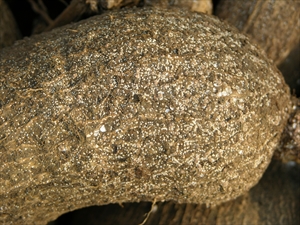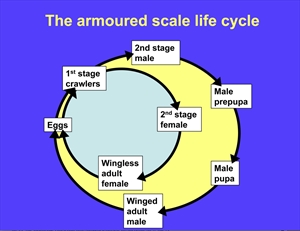Yam scale, turmeric root scale
Pacific Pests, Pathogens, Weeds & Pesticides - Online edition
Pacific Pests, Pathogens, Weeds & Pesticides
Yam scale (093)
Aspidiella hartii
Asia (India), Africa (West), Oceania. It is recorded from Fiji, Solomon Islands, and Tonga.
Yams, especially Dioscorea alata and Dioscorea esculenta. Ginger, taro and turmeric are minor hosts.
The scale insect damages stored yams. Large numbers turn the yams light grey (Photo 1). The scales have long tube-like mouthparts that pierce the skin of the yam tubers and feed on the flesh beneath.
The scale is an armoured species, so-called because it makes a hard covering over its body (Photos 2&3). This scale has males and females, and the females lay eggs. Armoured scales do not produce honeydew. [Honeydew is produced by many sucking insects, for example, soft scales and aphids; it is liquid waste from their bodies as they feed on plant sap. Often it falls to the leaves below where sooty mould fungi grow on it turning the leaves black (see Fact Sheet no. 51)].
The life cycle of the yam scale is shown (see Diagram). The crawlers are the active stage, walking or blown by wind to new hosts. Once the female settles down to feed, it secretes the round (1-2.5 mm diameter), brownish to brownish-grey waxy covering over its body - the armour. The scale lives beneath it, feeding and breeding. The second-stage male also settles down to feed and develops a scale cover, which is similar to that of the female but is rounder and slightly smaller. However, it goes through a resting stage, a pupa, and hatches as a tiny mosquito-like insect, with wings. It has no mouthparts so cannot feed. It lives for only a few hours or a few days. Its task is to find females and mate.
When large numbers of scales are present the yams become fibrous and this affects their quality. This is a common insect on stored yams in all countries where it is recorded.
Look for yams that have a light brown to grey appearance in storage. Use a hand lens to look for the scales, less than 1-2 mm diameter. They cannot be seen clearly with the naked eye.
CULTURAL CONTROL
- Check the surface of yams before they are stored. If scales are seen, refer to the chemical control section below.
- Inspect yams in storage regularly, and remove those that become infested with the scale. Use for food, or refer to the chemical control section below.
- Select tubers that are free of scale insects for planting.
RESISTANT VARIETIES
None known.
CHEMICAL CONTROL
- Use white oil (made from vegetable oils), soap solution or horticultural oil (made from petroleum) on yams infested with scale: (i) after harvest and before yams are stored; (ii) during storage, on yams when infestations begin; and (iii) at the time of planting before the tubers are cut (see Fact Sheet no. 56).
- White oil:
- 3 tablespoons (1/3 cup) cooking oil in 4 litres water
- ½ teaspoon pure hand soap, not detergent
- Shake well and use
- Soap:
- Use soap (pure soap, not detergent):
- 5 tablespoons of soap in 4 litres water.
- Commercial horticultural oil can also be used. White oil, soap and horticultural oil sprays work by blocking the breathing holes of insects causing suffocation and death. Spray the undersides of leaves; the oils must contact the insects. A second application of soap or oils may be necessary after 3-4 weeks.
- The addition of malathion is useful against scales insects, but it is likely to kill natural enemies.
- Synthetic pyrethroid insecticides are likely to be effective against the crawlers - crawlers are the active nymphs that spread infestations, but they are difficult to see as they are so small. And synthetic pyrethroids are likely to kill natural enemies.
____________________
When using a pesticide (or biopesticides), always wear protective clothing and follow the instructions on the product label, such as dosage, timing of application, and pre-harvest interval. Recommendations will vary with the crop and system of cultivation. Expert advice on the most appropriate pesticides to use should always be sought from local agricultural authorities.
AUTHORS Helen Tsatsia & Grahame Jackson
Information from CABI (2020) Aspidiella hartii (yam scale). Invasive Species Compendium. (https://www.cabi.org/isc/datasheet/7490). Photos 2&3 Georg Goergen, International Institute of Tropical Agriculture, Cotonou, Benin. Diagram Gillian Watson, California Department of Food and Agriculture, Sacramento.
Produced with support from the Australian Centre for International Agricultural Research under project PC/2010/090: Strengthening integrated crop management research in the Pacific Islands in support of sustainable intensification of high-value crop production, implemented by the University of Queensland and the Secretariat of the Pacific Community.







